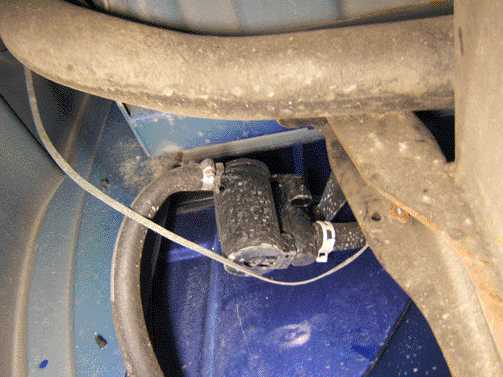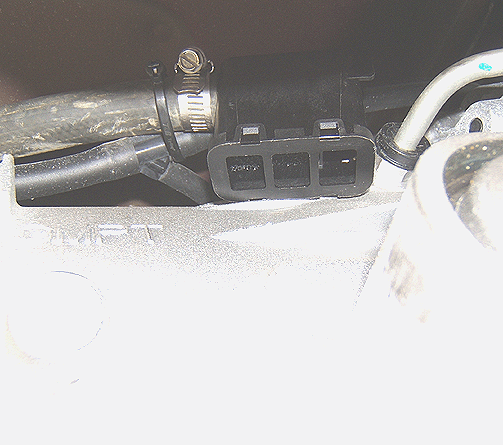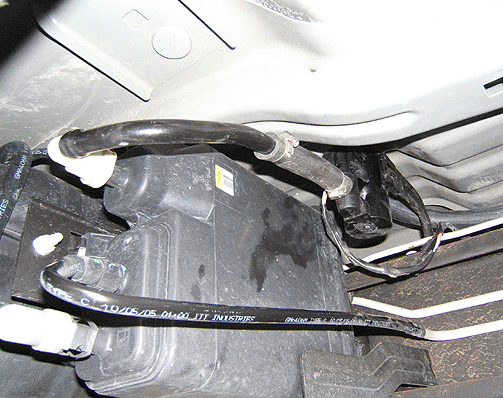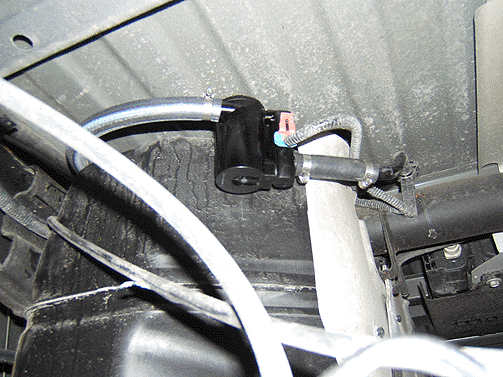DTC P0446 (Restricted/Blocked Evap Vent Path) Set, Check Engine Light On (Replace Evaporative Emission (EVAP) Vent Valve Solenoid Assembly and Add/Relocate Filter Box Using Service Kit)

| Subject: | DTC P0446 (Restricted/Blocked EVAP Vent Path) Set, Check Engine Light On (Replace Evaporative Emission (EVAP) Vent Valve Solenoid Assembly and Add/Relocate Filter Box Using Service Kit) |
| Models: | 1999-2007 Chevrolet Silverado (Classic) Models |
| 1999-2007 GMC Sierra (Classic) Models |
| 2007-2008 Chevrolet Silverado Models |
| 2007-2008 GMC Sierra Models |
This bulletin is being revised to add new style pickups to the models and update the correction information to include a new location for the filter box. Please discard Corporate Bulletin Number 02-06-04-037C (Section 06 -- Engine/Propulsion System).
Condition
Some customers whose vehicles are operated in dusty type environments, such as farming or mining off-road type applications, may comment about the illumination of the check engine light, with a DTC of P0446 (Restricted/Blocked EVAP Vent Path) being set.
Cause
Dirt and dust intrusion into the EVAP canister vent hose assembly, resulting in restricted air flow, may cause this condition.
Correction (1999-2007 Classic/Old Style Models)
After following the published SI diagnostics for P0446 and determining that the EVAP canister vent valve is the cause of the MIL light, replace the existing EVAP canister vent valve assembly with a new assembly. This new assembly is a sealed unit that is designed to be vented through a remote filter box. To ensure correct installation, follow the procedures below.
1999-2003 Model Year (Use Service Kit P/N 19152345)
- Raise the vehicle. Suitably support the vehicle.
- Disconnect the EVAP canister vent valve electrical connector, if equipped.
- Disengage the two vent valve pipe clips securing the pipe to the underbody. Remove the clips from the underbody and discard.
- Disconnect the vent valve pipe at the EVAP canister.
- Remove and retain the EVAP canister vent valve bracket mounting bolt.
- Remove the complete EVAP canister vent valve assembly with bracket attached and discard.
- Position and secure the new valve assembly to the frame bracket on the outside of the frame using the existing hole and mounting bolt.
- Connect the vent valve pipe to the EVAP canister.
- Install the two vent valve pipe clips into the existing underbody holes.
- Connect the EVAP canister vent valve electrical connector, if equipped.
- Attach bulk 5/8" heater hose to the vent valve port and secure using a clamp. Run a length as needed along the frame rail routing to the area above the transmission.
- Cut the hose to determined length and install the supplied filter box. Secure using a clamp.
- Remove the transmission support and lower the transmission assembly as necessary to allow for access to the new filter box location.
- Secure the filter box to the transmission vent hose just forward of the hose tee-section using a tie strap. DO NOT pinch or restrict the transmission vent hose. The filter box opening should be pointing downward.
- Raise the transmission and reinstall the transmission support.
- Tie strap the hose as needed along the frame rail in order to keep the hose away from pinch-points and heat sources.
- Lower the vehicle.

Important: The new canister vent valve will be installed in a new location, outside of the frame.
Tighten
Tighten the bracket mounting bolt to 12 N·m (106 lb in).

2004-2007 Model Year (Use Service Kit P/N 19152349)
- Raise the vehicle. Suitably support the vehicle.
- Disconnect the EVAP canister vent valve electrical connector.
- Disconnect the canister pipe from the vent valve.
- Push in the retainer and remove the existing canister vent valve from the fuel tank clip or mounting bracket. Discard the old valve.
- Cut back the existing canister pipe approximately 51 mm (2 in) to remove the quick connect end.
- Install the new canister vent valve to the fuel tank clip or mounting bracket.
- Cut bulk 5/8" heater hose to a length of approximately 76 mm (3 in). Install the hose between the vent valve and the canister pipe and secure using clamps.
- Attach bulk 5/8" heater hose to the vent valve port and secure using a clamp. Run a length as needed along the frame rail routing to the area above the transmission.
- Cut the hose to determined length and install the supplied filter box. Secure using a clamp.
- Remove the transmission support and lower the transmission assembly as necessary to allow for access to the new filter box location.
- Secure the filter box to the transmission vent hose just forward of the hose tee-section using a tie strap. DO NOT pinch or restrict the transmission vent hose. The filter box opening should be pointing downward.
- Raise the transmission and reinstall the transmission support.
- Connect the EVAP canister vent valve electrical connector.
- Tie strap the hose as needed along the frame rail in order to keep the hose away from pinch-points and heat sources.
- Lower the vehicle.
Crew Cab Short Box Shown Below, Other Configurations Similar

Extended Cab Short Box Shown Below, Other Configurations Similar


Correction (2007-2008 New Style Models)
After following the published SI diagnostics for P0446 and determining that the EVAP canister vent valve is the cause of the MIL light, replace the EVAP canister vent valve assembly and relocate the remote filter box. To ensure correct installation, follow the procedures below.
Use Service Kit P/N 19152349
- Raise the vehicle. Suitably support the vehicle.
- Disconnect the EVAP canister vent valve electrical connector.
- Disconnect the vent valve pipe quick connect from the canister.
- Either cut the existing valve vent pipe and leave the remaining section of pipe in the vehicle or remove along with the valve.
- Push in the retainer and remove the existing canister vent valve from the fuel tank clip or mounting bracket.
- Cut back the existing canister pipe approximately 51 mm (2 in) and retain the pipe for use with new valve.
- Connect the canister pipe quick connect to the canister.
- Install the new canister vent valve to the fuel tank clip or mounting bracket.
- Cut bulk 5/8" heater hose to a length of approximately 76 mm (3 in). Install the hose between the vent valve and the canister pipe and secure using clamps.
- Attach bulk 5/8" heater hose to the vent valve port and secure using a clamp. Run a length as needed along the frame rail routing to the passenger side area above the transmission.
- Cut the hose to determined length and install the supplied filter box. Secure using a clamp.
- Remove the transmission heat shield, if necessary.
- Remove the transmission support and lower the transmission assembly as necessary to allow for access to the new filter box location.
- Secure the filter box to the transmission vent hose just forward of the hose tee-section using a tie strap. DO NOT pinch or restrict the transmission vent hose. The filter box opening should be pointing downward.
- Raise the transmission and reinstall the transmission support.
- Reinstall the transmission heat shield.
- Connect the EVAP canister vent valve electrical connector.
- Tie strap the hose as needed along the frame rail in order to keep the hose away from pinch-points and heat sources.
- Lower the vehicle.
2500 Crew Cab Short Box Shown Below, Other Configurations Similar

1500 Extended Cab Short Box Shown Below, Other Configurations Similar


Parts Information
Part Number | Description | Qty | Material Allowance |
|---|---|---|---|
19152345 (1999-2003 Model Year) | Solenoid Kit, EVAP Emission Canister Vent Valve | 1 | -- |
19152349 (2004-2008 Model Year) | Solenoid Kit, EVAP Emission Canister Vent Valve | 1 | -- |
9438383 (5/8" X 25' roll) | Hose | Cut to Length | $10.80 USD ($22.59 CAD) |
12337820 (10 per pack) | Tie-Strap | 5 | $3.80 USD ($4.55 CAD) |
15620999 (10 per pack) | Clamp | 2 (1999-2003) or 4 (2004-2008) | $3.78 USD ($7.08 CAD) (1999-2003) or $7.56 USD ($14.17 CAD) (2004-2008) |
Put unused material on shelf for future use.
Warranty Information
For vehicles repaired under warranty, use:
Labor Operation | Description | Labor Time |
|---|---|---|
J7908* | Replace Evaporative Emission (EVAP) Vent Valve Solenoid Assembly and Add/Relocate Filter Box Using Service Kit | 1.1 hrs** |
* This labor operation number is for bulletin use only. This number will not be published in the Labor Time Guide. **Diagnosis time is included in this labor time. | ||
